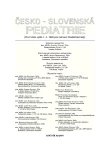Long-term Results of Gastric Transposition in Children
Authors:
J. Kalousová; J. Šnajdauf; M. Rygl; D. Pachmannová; J. Stýblová; M. Vyhnánek; J. Šulc 1; R. Fryč; H. Křížová 2; L. Tomášek 3
Authors‘ workplace:
Klinika dětské chirurgie, UK 2. LF a FN Motol, Subkatedra dětské chirurgie IPVZ, Praha
přednosta prof. MUDr. J. Šnajdauf, DrSc.
; Pediatrická klinika, UK 2. LF a FN Motol, Praha
přednosta prof. MUDr. J. Lébl, DrSc.
1; Klinika nukleární medicíny a endokrinologie UK 2. LF a FN Motol, Praha
přednosta doc. MUDr. P. Vlček, CSc.
2; Státní ústav radiační ochrany, Praha
ředitel ing. R. Filgas
3
Published in:
Čes-slov Pediat 2007; 62 (6): 376-383.
Category:
Original Papers
Overview
Aim of study:
To analyze outcome, nutritional status, feeding, gastrointestinal and respiratory problems and quality of life of children with gastric transposition (GT), further to asses the influence of GT on pulmonary functions, and determine the impact of changed gastric evacuation on respiratory and gastrointestinal symptoms. The results in children with GT for long-gap esophageal atresia (EA) and caustic injury (CI) are compared.
Methods:
Basic demographic data and history of GT were gained from hospital and outpatient charts. Data about feeding problems and gastrointestinal and respiratory symptoms and quality of life were collected by a questionnaire filled in by parents or children. Nutritional status evaluation was based on anthropometrical parameters: height, weight, head and arm circumference and skin fold thickness: triceps, subscapular, and suprailiac. Gastric emptying was assessed with 99mTc Sn-colloid-labelled meal. Lung functions were measured using either spirometry or plethysmography in cooperating children.
Results:
The incidence of symptoms is relatively high, only 26% of children are symptom free. In 4 children, (21%) significant postprandial hypoglycemia was documented. The quality of life is nevertheless considered good or acceptable in 84% of cases. Anthropometrics are below age appropriate norm (significantly worse for weight and arm circumference in EA), but SD is not greater then –1.5 SD. Children with EA show non-significant tendency to faster gastric emptying. The evacuation does not correlate with symptoms of dumping. FVC and FEV1 are significantly worse for children with EA; there is a relation between the results of lung function test and number of thoracotomies before GT.
Conclusions:
Gastric transposition is an acceptable method of esophageal substitution in childhood despite considerable respiratory, swallowing and gastrointestinal symptomatology the quality of life is considered by the patients or their parents to be acceptable. Anthropometrics and lung function test results are below age appropriate norm, results are worse in AE. Clinical symptomatology does not correlate with function tests and is worse in children with CI.
Key words:
esophageal substitution, gastric transposition, long-gap esophageal atresia, caustic injury, lung function tests, dumping syndrome
Labels
Neonatology Paediatrics General practitioner for children and adolescentsArticle was published in
Czech-Slovak Pediatrics

2007 Issue 6
Most read in this issue
- Different Manifestations of the Fragile X Chromosome Syndrome and Their Causes
- Congenital Myasthenic Syndrome (CMS)
- Nitrobenzene Poisoning of a 4.5-year Boy
- Long-term Results of Gastric Transposition in Children
